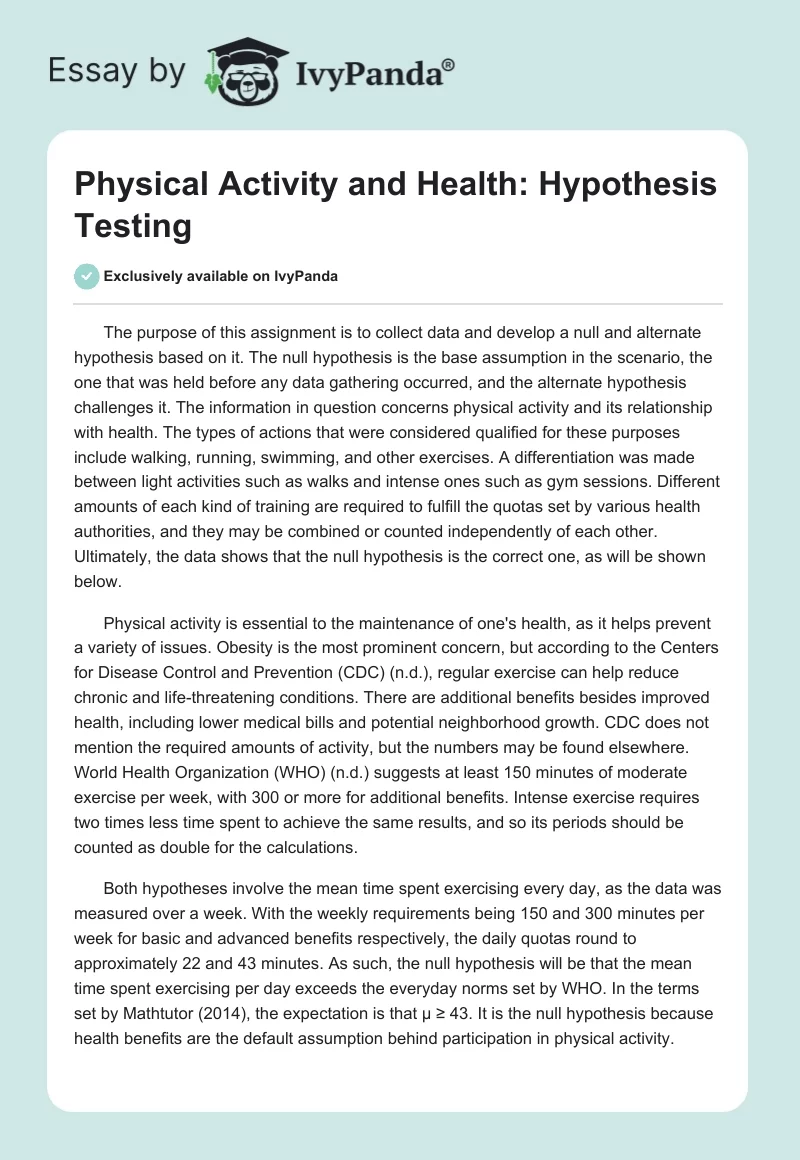The purpose of this assignment is to collect data and develop a null and alternate hypothesis based on it. The null hypothesis is the base assumption in the scenario, the one that was held before any data gathering occurred, and the alternate hypothesis challenges it. The information in question concerns physical activity and its relationship with health. The types of actions that were considered qualified for these purposes include walking, running, swimming, and other exercises. A differentiation was made between light activities such as walks and intense ones such as gym sessions. Different amounts of each kind of training are required to fulfill the quotas set by various health authorities, and they may be combined or counted independently of each other. Ultimately, the data shows that the null hypothesis is the correct one, as will be shown below.
Physical activity is essential to the maintenance of one’s health, as it helps prevent a variety of issues. Obesity is the most prominent concern, but according to the Centers for Disease Control and Prevention (CDC) (n.d.), regular exercise can help reduce chronic and life-threatening conditions. There are additional benefits besides improved health, including lower medical bills and potential neighborhood growth. CDC does not mention the required amounts of activity, but the numbers may be found elsewhere. World Health Organization (WHO) (n.d.) suggests at least 150 minutes of moderate exercise per week, with 300 or more for additional benefits. Intense exercise requires two times less time spent to achieve the same results, and so its periods should be counted as double for the calculations.
Both hypotheses involve the mean time spent exercising every day, as the data was measured over a week. With the weekly requirements being 150 and 300 minutes per week for basic and advanced benefits respectively, the daily quotas round to approximately 22 and 43 minutes. As such, the null hypothesis will be that the mean time spent exercising per day exceeds the everyday norms set by WHO. In the terms set by Mathtutor (2014), the expectation is that µ ≥ 43. It is the null hypothesis because health benefits are the default assumption behind participation in physical activity.
The alternate hypothesis will be that the daily exercise means is not sufficient to suit the norm set for additional benefits. It does not mention the lower limit required for essential fitness because according to Mathtutor (2014), the alternate hypothesis has to contradict the null directly. Furthermore, as “Module 3 – SLP” (n.d.) mentions that the exercise involved includes gym sessions, the overall time spent is overwhelmingly likely to satisfy the lower requirement. In the terms set by Mathtutor (2014), this hypothesis would expect that µ < 43. If this hypothesis is correct, then a similar test for the 22 minutes requirement will be necessary to determine whether the activity is sufficient for any need.
The data collected indicates that the mean of the physical activity that was obtained over the week of observations is above 43 minutes, even when the increased efficiency of gym sessions is not taken into consideration. As such, the null hypothesis is satisfied, and the alternate hypothesis is rejected. The amount of physical activity conducted on average every day is sufficient to deliver significant health benefits, according to the World Health Organization’s estimate. The assignment was valuable to the understanding of the formation of null and alternate hypotheses with an existing dataset and a vague objective through the examination of a real-world scenario.
References
Centers for Disease Control and Prevention. (n.d.). Physical activity builds a healthy and strong America. Web.
Mathtutor. (2014). Null and alternate hypothesis – Statistical hypothesis testing – Statistics course. [Video file]. Web.
Module 3 – SLP. (n.d.).
World Health Organization. (n.d.). Physical activity and adults. Web.


